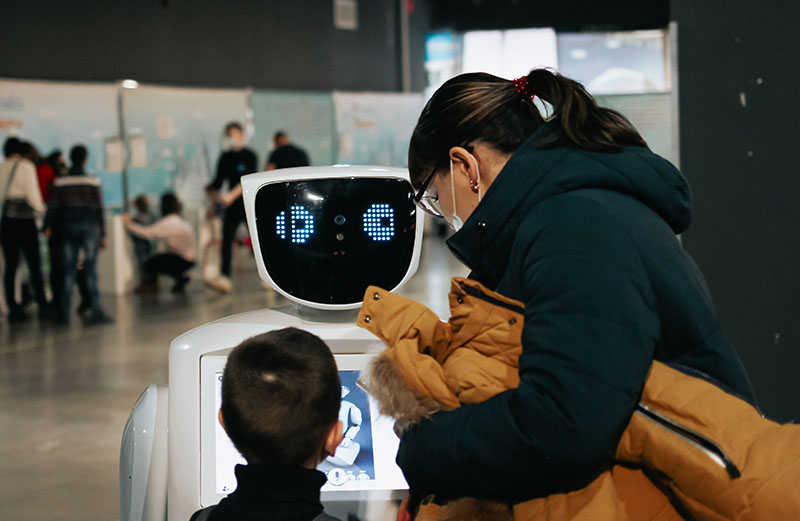Executive Summary
India’s $250B+ technology services industry—comprising BPM, IT, and R&D—is entering a new era defined by Artificial Intelligence (AI). This evolution is not about workforce reduction, but about redefining how roles are performed, value is delivered, and careers are shaped.
As AI becomes embedded across service lines and workflows, the focus must shift from disruption response to structured workforce transformation. India has the scale, capability, and credibility to lead this transition—provided there is proactive, cross-sector execution. This is a call to reinvent—not reduce—India’s technology services workforce for the AI age.
From Digital Excellence to AI-Native Delivery
India’s global delivery leadership, built on digital scale and operational resilience, is now being augmented by AI. This next wave of transformation is characterized not by substitution of jobs, but by elevation of roles through AI-enhanced productivity, intelligence, and innovation.
AI is reshaping how work is delivered in three fundamental ways:
- Process execution → AI-enabled decisioning and automation
- Service roles → AI-human collaboration roles
- Skill stacks → Fluid, cross-functional capabilities
This transformation is sector-specific, role-driven, and forward-looking. It presents an opportunity to uplift India’s global positioning—not undermine it.
India’s Advantage: Scale with Adaptability
India holds a unique edge in the global AI workforce transformation:
- A digitally literate workforce already embedded in global delivery chains
- Strong foundational skills in engineering, systems thinking, and data
- Early adoption of digital technologies and automation frameworks
- Trusted relationships with global clients seeking AI-infused services
But these strengths must now be recalibrated to prioritize AI fluency, continuous upskilling, and workforce adaptability at scale.
Four-Pillar Transition Model for AI-Augmented Services
India’s transformation to an AI-augmented workforce must be orchestrated across four synergistic stakeholders:
Stakeholder | Mandate in the AI Transition |
|---|
Individuals | Proactively develop AI-aligned skills within their domain and function |
Academia | Embed AI-era competencies, tools, and applied project work into mainstream curricula |
Industry | Redesign job roles and delivery models to integrate AI workflows and foster continuous reskilling |
Policy & Public Institutions | Enable scalable skilling infrastructure, co-funding models, and academic-industry collaboration platforms |
This is not a linear migration—it is a national workforce reinvention anchored in job evolution, not elimination.
What This Article Delivers
This paper outlines:
- A sector-specific role transformation framework
- A detailed execution playbook for academia, industry, and individuals
- Enablers and models for role-wise workforce evolution
India’s opportunity is not to defend against AI, but to lead through it—by becoming the world’s most future-ready talent hub across BPM, IT, and R&D.
Role Evolution Across India’s Technology Services Sector
AI is transforming “what work is” across all layers of service delivery—from rules-based processing to intelligent interaction, from code execution to co-creation, and from verification to autonomous engineering. India’s leadership lies in transitioning roles, not replacing them.
The following table maps each Current role to its Future evolution, along with the capability shifts required for reinvention—organized by sector.
BPM Services – Moving from Execution to Intelligence
Current Role | Future Role | Focus Capability Shifts |
Voice Agent | Conversational AI Copilot | NLP, real-time dialogue management, prompt writing |
KYC Analyst | AI Compliance Validator | Intelligent document processing, regtech platforms |
Claims Processor | AI Workflow Designer | Workflow automation, LLM augmentation |
Collections Executive | Risk Score Validator | Predictive modeling, credit AI |
Customer Support Analyst | CX Insights Analyst | Journey analytics, behavior modeling |
Data Entry Operator | Data Workflow Orchestrator | No-code RPA tools, API automation |
HR Shared Services Exec | Workforce Intelligence Analyst | People analytics, visualization tools |
Procurement Analyst | Source-to-Pay AI Analyst | AI sourcing tools, spend analytics |
Finance Ops Executive | AI-Augmented Ops Designer | Auto-reconciliation, anomaly detection |
IT Services – Redefining Digital Engineering and Operations
Current Role | Future Role | Focus Capability Shifts |
Manual QA Tester | AI Test Copilot | Prompt-based test case generation, GenAI QA tools |
Automation Test Engineer | GenAI QA Architect | Test pipeline orchestration, LLM-based test strategies |
Helpdesk Support | AI ITSM Analyst | Conversational bots, incident auto-resolution |
Infra Support Executive | AIOps Engineer | Observability tools, self-healing infra patterns |
Backend Developer | AI-Augmented Backend Dev | Code copilots, refactoring and optimization |
Frontend Developer | Prompt-First UI Developer | Conversational UI, AI-native front-end coding |
Full-Stack Developer | AI-Paired Developer | Multimodal development with AI assistance |
DevOps Engineer | MLOps Engineer | Model deployment lifecycle, ML CI/CD integration |
Functional Analyst | Business Copilot Designer | Prompt architecture, semantic search modeling |
Cloud Architect | AI-Native Infra Architect | AI workload distribution, hybrid optimization |
Cybersecurity Analyst | AI Threat Defense Analyst | AI-enabled detection, anomaly hunting |
Data Engineer | AI DataOps Engineer | Synthetic data generation, real-time pipelines |
Solution Architect | AI Capability Architect | Domain-specific AI system design |
Database Administrator | AI-Augmented DBA | Autonomous database tuning, query intelligence |
RPA Developer | Hyperautomation Engineer | Multi-platform integration, LLM-based bots |
R&D Services – Engineering with Intelligence at the Core
Current Role | Future Role | Focus Capability Shifts |
CAD Designer | Generative Design Engineer | AI-based modeling tools, simulation constraints |
Embedded Tester | AI-Driven V&V Architect | Simulation-in-loop, test orchestration |
Embedded Developer | Adaptive Systems Engineer | AI for embedded platforms, autonomous control |
Simulation Engineer | Digital Twin Modeler | Data fusion, live simulation feeds |
V&V Engineer | Model-in-Loop Validator | Synthetic scenario generation, edge testing |
PCB Designer | AI-EDA Specialist | AI-driven circuit design, board layout prediction |
Mechatronics Engineer | Smart Robotics Developer | Embedded ML, adaptive response design |
Reliability Engineer | Predictive Maintenance Architect | Sensor analytics, failure pattern prediction |
Functional Safety Engineer | AI Safety Analyst | Model assurance, scenario validation |
Control Systems Engineer | AI Control Logic Designer | Adaptive feedback modeling |
HMI Designer | Conversational UX Engineer | Voice-first UI, gesture and NLP integration |
FPGA Developer | AI-Accelerated FPGA Architect | High-speed parallelism with AI inference |
Summary Perspective: Transition as Capability Reinvention
India’s Technology services industry is undergoing a human-centric productivity revolution—one where AI elevates every role and unlocks new forms of value creation.
“Every job listed here is not at risk—it is at a pivot point for reinvention.”
Role-Specific Execution Plan for Capability Transformation
A successful transition into an AI-powered services era requires role-by-role alignment across Individuals, Academia, and Industry. The table below presents practical next steps by sector, anchored in each role’s evolution journey.
BPM Services – From Process to Insight-Led Intelligence
Current Role | Futre Role | Individual Actions | Academia Actions | Industry Actions |
Voice Agent | Conversational AI Copilot | Learn prompt design, LLM workflows | Introduce NLP + AI dialogue labs | Set up bot testing environments |
KYC Analyst | AI Compliance Validator | Train on document automation tools | Launch regtech + IDP programs | Integrate with real-world KYC datasets |
Claims Processor | AI Workflow Designer | Understand process orchestration | Build LLM-based claims case studies | Deploy journey-based claim bots |
Customer Support Analyst | CX Insights Analyst | Learn journey analytics tools | Add behavior modeling coursework | Enable AI-based support copilots |
HR Shared Services Exec | Workforce Intelligence Analyst | Train in people analytics dashboards | Offer workforce analytics curriculum | Use AI-based HR simulations |
Data Entry Executive | Data Workflow Orchestrator | Learn no-code automation platforms | Introduce RPA + AI input modules | Create end-to-end workflow labs |
IT Services – From Code Delivery to Co-Development with AI
Current Role | Future Role | Individual Actions | Academia Actions | Industry Actions |
Manual QA Tester | AI Test Copilot | Learn prompt-based test scripting | Introduce GenAI QA use cases | Deploy copilots in test labs |
Infra Support Exec | AIOps Engineer | Upskill in monitoring and self-healing infra | Teach observability + AIOps | Build AIOps sandboxes |
IT Helpdesk Support | AI ITSM Analyst | Master ticket automation and bot configuration | Add AI-ITSM modules | Integrate with LLM-powered helpdesk systems |
Backend/Frontend Dev | AI-Augmented Developer | Learn AI-paired coding and optimization | Launch prompt-first programming curriculum | Implement code review bots |
DevOps Engineer | MLOps Engineer | Understand model deployment CI/CD | Offer MLOps lab programs | Run ML pipeline hackathons |
Functional Analyst | Business Copilot Designer | Learn task-to-prompt frameworks | Introduce enterprise LLM interfaces | Deploy copilots in client delivery |
Cybersecurity Analyst | AI Threat Defense Analyst | Learn AI-driven threat modeling | Launch threat AI curriculum | Run real-time anomaly use cases |
Data Engineer | AI DataOps Engineer | Learn real-time ETL and synthetic data tools | Add DataOps + AI modules | Deploy data generation labs |
Cloud Architect | AI-Native Infra Architect | Master hybrid AI workload orchestration | Offer edge-cloud optimization programs | Launch platform-based infra simulators |
RPA Developer | Hyperautomation Engineer | Integrate LLM with workflow builders | Launch hyperautomation frameworks | Use co-pilot driven bots for tasks |
R&D Services – From Physical Engineering to Intelligent Design Systems
Current Role | Futre Role | Individual Actions | Academia Actions | Industry Actions |
CAD Designer | Generative Design Engineer | Learn AI modeling tools (e.g. Autodesk AI) | Integrate generative design workflows | Set up GenAI design platforms |
Embedded Tester | AI-Driven V&V Architect | Upskill in scenario-based validation | Add model-in-loop testing modules | Use synthetic test environments |
Simulation Engineer | Digital Twin Modeler | Learn twin development and calibration | Introduce twin + sensor fusion curriculum | Simulate industrial twin environments |
PCB Designer | AI-EDA Specialist | Master AI-based layout tools | Include EDA + AI-assisted design | Deploy AI-EDA simulation platforms |
Mechatronics Engineer | Smart Robotics Developer | Learn embedded ML and control logic | Add AI + robotics curriculum | Prototype autonomous robot systems |
Reliability Engineer | Predictive Maintenance Architect | Learn anomaly prediction & asset modeling | Launch failure analytics courses | Use predictive tools in maintenance labs |
HMI Designer | Conversational UX Engineer | Train in voice and gesture UX with LLMs | Add multimodal UX courses | Use AI-led design tools in projects |
Strategic Recommendations
- Role-Based Credentials: Design stackable certifications aligned to each future job role
- Immersive Talent Labs: Simulate real job transitions through co-created learning labs
- AI Role Accelerator Program: Run 3–6 month transition sprints by sector + job cluster
- Academia–Industry Co-Faculty: Appoint job-role-specific industry mentors for colleges
Framing the Opportunity
India stands at a pivotal juncture. With 5 million+ professionals across BPM, IT Services, and R&D sectors, we are uniquely positioned to lead the global AI-powered services transformation—not by replacing jobs, but by recasting talent into higher-order, AI-augmented roles.
The next five years must focus on enabling a massive workforce shift from process execution to intelligent orchestration, led by human-AI collaboration.
What Success Looks Like by 2030
Outcome Area | 2030 Target State |
Job Role Transition | 80%+ of digital roles AI-integrated without shrinkage in net employment |
Capability Uplift | AI augmentation in every job cluster across sectors |
Academia Readiness | 1000+ institutions offering role-aligned AI curriculum |
Industry Maturity | Sector-wide adoption of AI copilots, testbeds, and hybrid teams |
Global Leadership | India recognized as global source of AI-ready services talent |
India’s AI Workforce Acceleration Blueprint
For Academia
- Curriculum Reset: Make AI tools, prompt engineering, and role-based LLM fluency mandatory across disciplines
- Role Labs: Co-build GenAI, DevAI, and TwinAI labs with industry for immersive learning
- Faculty Uplift: Create faculty-industry immersion programs across all tech services domains
For Industry
- Transition-by-Design: Create internal blueprints for job role transitions, mapped to AI capabilities
- Co-Skill at Scale: Partner with academia to deliver AI bootcamps and nano-degrees at feeder colleges
- Adopt Copilot Platforms: Institutionalize AI copilots in delivery, operations, and engineering
For Individual Professionals
- Self-Led Re-skilling: Embrace AI augmentation as a core competency—not a disruption
- Specialize by Role: Transition from generic upskilling to role-specific capability building
- Portfolio Development: Maintain a showcase of AI-powered projects, not just certifications
The India Advantage
India's strength lies in its depth, diversity, and deployability of talent. The AI era will not shrink India’s role—it will elevate it, if we act now.
“This is not about saving jobs. It’s about redefining work—and letting India lead the way.”
Disclaimer
The views, thoughts, and opinions expressed in this blog are solely those of the author and any content provided on this blog is for informational purposes only.























